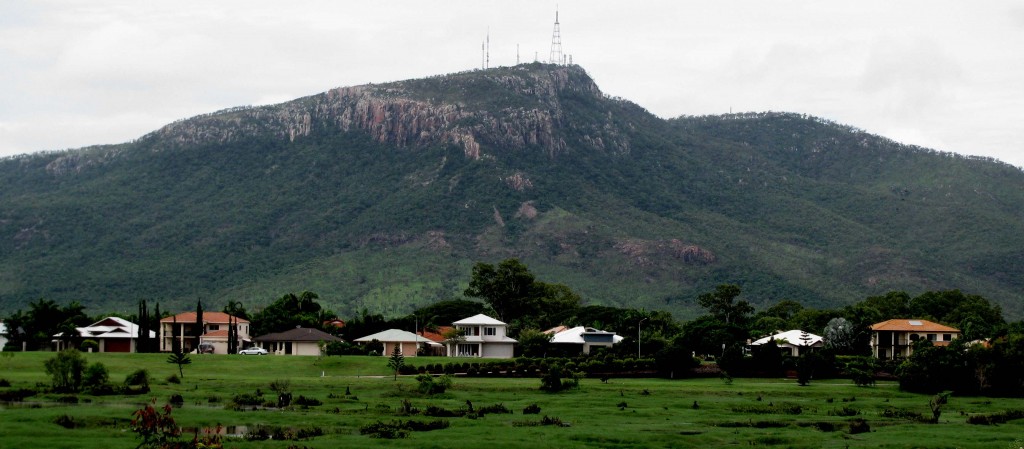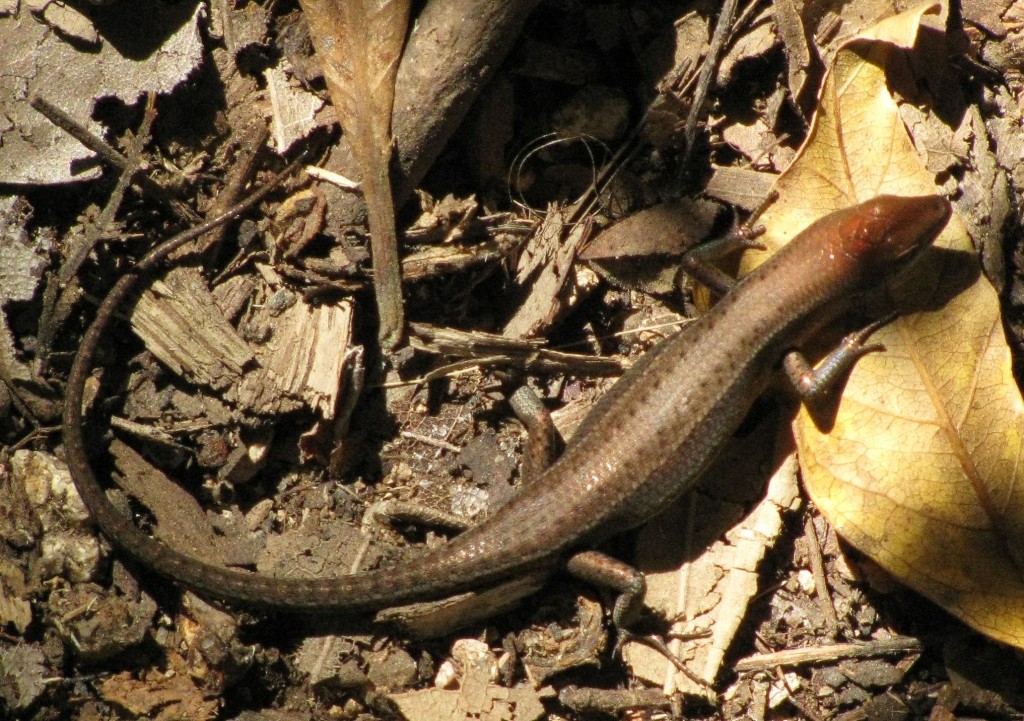
Mount Stuart and Annandale, Townsville (© Magi Nams)
When I left the house at 6 a.m., I spotted honeyeaters congregated on overhead wires, silent, awaiting the sun. And today, like yesterday, we did have sun, the sky mostly clear, the air still and warm and humid, as in those early days of our time here in Townsville. I ran and walked alongside the golf course and then westward in the river park, headed for Aplins Weir and beyond. Beside me, the river, although still flooded, had dropped at least half a metre since yesterday, its face serene and unruffled in the clear morning light. In the distance, Mount Stuart’s cliffs were red sheets of rock hung above the city.
A pair of pheasant coucals claimed a backyard poinciana as their territory, the male booming out low whoops reminiscent of a great horned owl’s hoots, though slowly descending in pitch and ending with a faint ‘p’ sound. Six red-tailed black-cockatoos pumped wing muscle overhead and scraped the air with rasping calls, as though inspecting the efforts of early morning exercisers on the parkway. Today, a striking majority were women, a number of whom were putting the fitness stations to good use. Last week, when I ran through rain and sometimes through torrential downpours, the path was almost empty, but today the throngs have returned, creating more dodging for me, but better overall health for Townsville’s population.
While I stretched after my exercise, I heard on national radio that farmers and ranchers in western and central Queensland – some in localities that haven’t had rain for two or three years – are rejoicing because rivers are full after the monsoonal rains of last week and Saturday.1
Later, while I was writing, I spotted a tiny skink darting up a palm trunk. When it paused to scan its surroundings, I studied it through my binoculars, which I keep handy on my desk for just such observations. The minute reptile, which was perhaps 5 centimetres long and dark brown in colour, had a yellow stripe running down each side of its back, a reddish head, and a tail that appeared to be bluish. Whereas geckos are soft-skinned, nocturnal lizards with big eyes, skinks are sleek, shiny-scaled lizards that move very quickly and frequently bask in the sunlight.
I picked up my copy of Steve Wilson and Gerry Swan’s A Complete Guide to Reptiles of Australia 2 and decided to have a go at identifying the skink, a task which I soon discovered was far more formidable than I had envisioned. Of Australia’s 864 described species of reptiles (there are more yet to be described),3 over 370 are skinks, with the number of these also increasing as more newly found species are described.4 Thus, almost half of my field guide is devoted to skinks, to which Wilson and Swan paid homage by stating, “In terms of abundance, number of species, distribution and diversity of form, skinks are the most successful group of Australian vertebrates… From wave-washed rocks on Cape York to the chilly heaths of southern Tasmania, skinks are usually the most numerous reptiles.”4
Undeterred, I began flipping through the 185 pages of skink descriptions, my task somewhat simplified by the distribution maps that eliminated many species from consideration. Most of the skinks illustrated in the guide are small, with their body length (excluding tail) under 10 centimetres, the glaring exception to this generalization being 5 species of blue-tongued skinks that reach 30 centimetres in length.5 The photographs in the guide illustrate incredibly diverse patterns of stripes and specks of colour adorning various species, some quite stunningly beautiful. They also illustrate a variety of skink body shapes of which I was completely unaware, including skinks without legs that look like mini-snakes, skinks with exceedingly long mid-sections and tiny, necessarily widely-spaced pairs of legs, and the robust blue-tongued skinks with their large heads and short tails.5 After approximately 45 minutes of perusing the guide, I decided I had found it – the garden skink, a widespread species commonly found in city gardens and occurring from Cairns to South Australia and Tasmania.6
That exercise in identification brought home to me a big difference between the vertebrate fauna of Australia and that of North America (excluding Mexico), namely the prominence of reptiles Down Under. The numbers of species of mammals and birds that occur in America and Canada combined (474 mammals;7 957 birds8) are in the same ballbark as the Aussie numbers (378 mammals9; 851 birds10), but Australia has two and a half times as many reptiles – 864 versus 339.2,11 As pointed out by Wilson and Swan, the explanation for this may lie in the vast area of Australia comprised of arid vegetation zones that provide excellent habitat for reptiles.3

Rainbow Sink Carlia pectoralis on Magnetic Island, Queensland (© Vilis Nams)
In late afternoon, I allowed breezes to blow humidity-laden air through the house. They carried on them the raucous screeches of rainbow lorikeets, my favourite avian rascals. From my home office in Nova Scotia, I frequently hear the strident calls of blue jays. Here, my background music is provided by parrots.
After supper, Vilis and I strode north past the golf course and into the river park, where warm wind rustled palm leaves and golden light spilled from windows into the oncoming darkness. The sky was blanketed with batts of grey carded wool lit by a golden sunset caught between city horizon and cloud. Aviation warning lights atop Castle Hill and Mount Stuart shone their red beacons against deep blue sky, and black flying foxes flocked westward, sailing into the sunset. The voices of crickets and cicadas seemed mellow, as mellow as the warm wind and soft summer night air.
“The best thing about Townsville is this river park,” I told Vilis.
He said, teasing, “So it’s good they didn’t build houses right up to the water?”
“They wouldn’t. There’s still flooding.” But I knew he knew what I meant. We walked home with darkness settling in softly around us. The evening was a keeper, right up there on par with those caressing summer nights in Nova Scotia when gentle breezes like a lover’s touch hold sweet warmth and inexplicable yearning.
References:
1. ABC News. Qld authorities brace for more rain. Monday, Feb 1, 2010, 8:20 a.m. Accessed 20-Nov-2010. http://www.abc.net.au/news/stories/2010/02/01/2806185.htm
2. Steve Wilson and Gerry Swan. A Complete Guide to Reptiles of Australia. 2003. New Holland Publishers (Australia) Pty Ltd, Sydney, 512 p.; 3. Ibid, p. 16; 4. Ibid, p. 134; 5. Ibid, pp. 135-317; 6. Ibid, pp. 252-253.
7. Robert J. Baker, Lisa C. Bradley, Robert D. Bradley, Jerry W. Dragoo, Mark D. Engstrom, Robert S. Hoffman, Cheri A. Jones, Fiona Reid, Dale W. Rice and Clyde Jones. Revised Checklist of North American Mammals North of Mexico, 2003. Museum of Texas Tech University Occasional Papers Number 229, 01 December 2003. Accessed 3-Feb-2010. http://www.msb.unm.edu/mammals/publications/Baker2003.pdf
8. American Birding Association. ABA Checklist. © 2010 American Birding Association, Inc. Accessed 3-Feb-2010. http://www.aba.org/checklist/
9. Peter Menkhorst and Frank Knight. A Field Guide to the Mammals of Australia. Oxford University Press, South Melbourne, Victoria, 273 p.
10. Bird Observation & Conservation Australia. 2008. BOCA’s Little Blue Bird List. BOCA, Nunawading, Victoria, 40 p.
11. Brian I. Crother, Jeff Boundy, Jonathan A. Campbell, Kevin de Queiroz, Darrel R. Frost, Richard Highton, John B. Iverson, Peter A. Meylan, Tod W. Reeder, Michael E. Seidel, Jack W. Sites, Jr., Travis W. Taggart, Stephen G. Tilley, David B. Wake. Scientific and Standard English Names of Amphibians and Reptiles of North America North of Mexico, with Comments Regarding Confidence in Our Understanding. Society for the Study of Amphibians and Reptiles Herpetological Circulars, Herpetological Circular No. 29, November 2000. © 2000 Society for the Study of Amphibians and Reptiles. Accessed 3-Feb-2010. http://www.ssarherps.org/pdf/Crother.pdf


